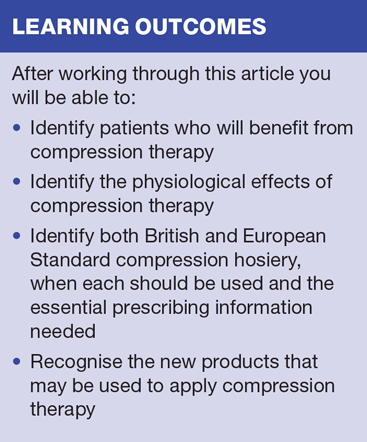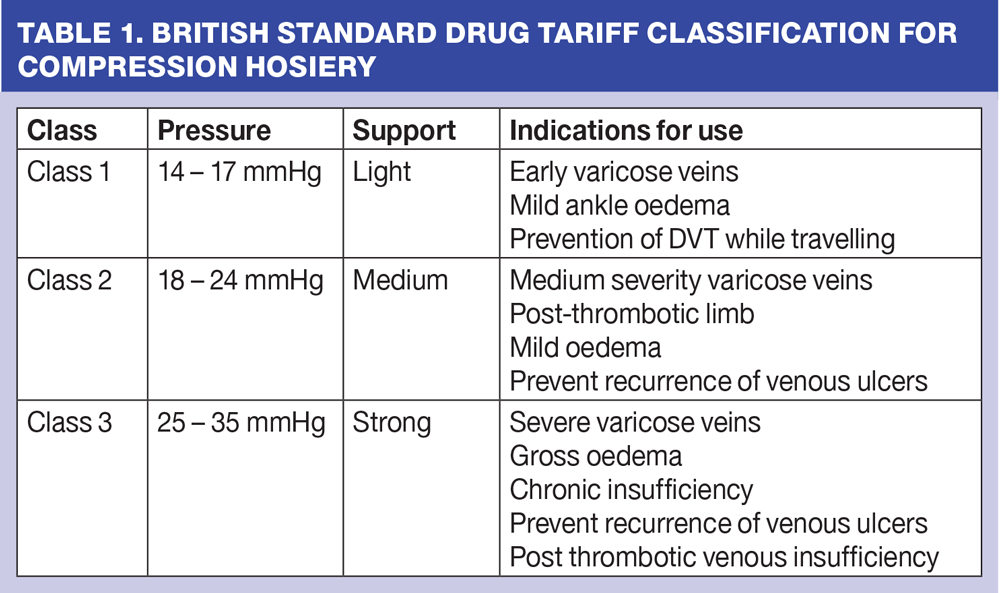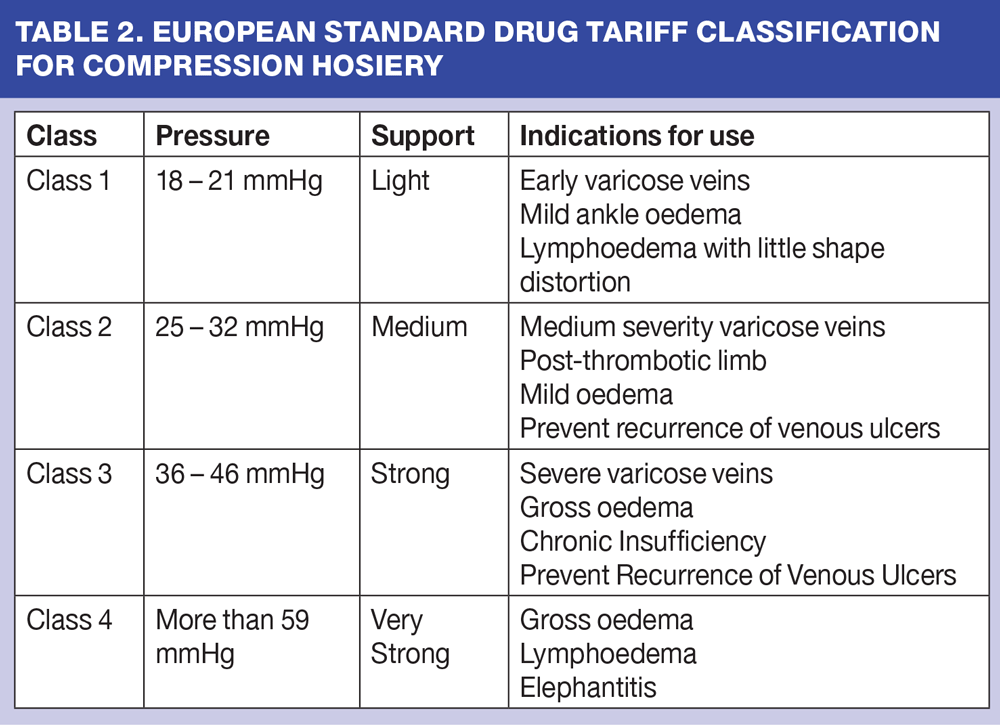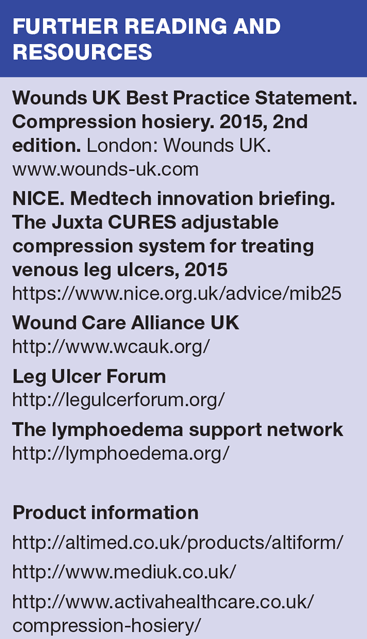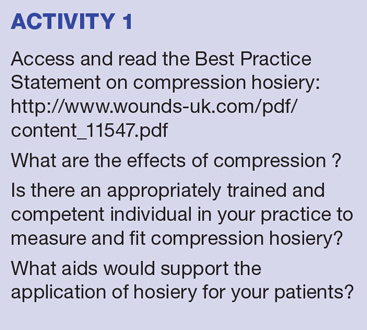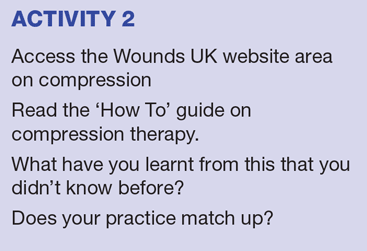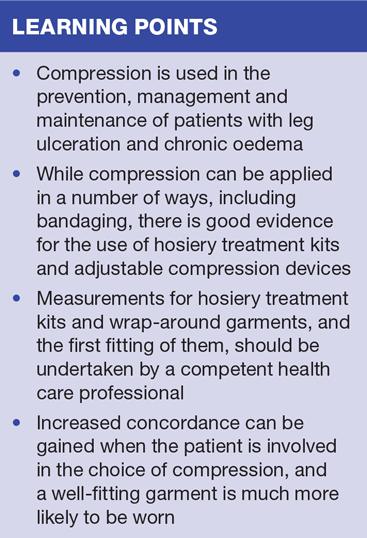Options for compression dressings
Jackie Stephen-Haynes
Jackie Stephen-Haynes
RGN, DN, DipH, BSc (Hons), ANP. Masters in Clinical Nursing, PG DipResearch, PGDip Ed
Professor in Tissue Viability, Professional Development Unit, Birmingham City University and Consultant Nurse, Worcestershire Health and Care NHS Trust
Rosie Callaghan
RGN. BSc Hons
Tissue Viability Nurse Specialist, Worcestershire Health and Care NHS Trust
Stourport Health Centre, Worcester Road, Stourport-on-Severn
Compression hosiery is used in the prevention, management and maintenance of venous and lymphatic disease and new, clinically and financially cost effective ways of achieving appropriate compression, including compression treatment kits and wrap around garments, are now available
Venous and lymphatic disease can lead to lower leg ulceration and chronic oedema. These are recognised as increasingly challenging conditions. Their incidence is exacerbated by our ageing population, diabetes, obesity and other co-morbidities,1 and they require the clinician to be well informed of the latest options for treatment. In today’s NHS emphasis is rightly given to the delivery of evidence based care and, with increased patient awareness and demand for quality care, has led to a focus on both clinical and financial outcomes and a greater emphasis on efficiency improvements.2
Venous insufficiency affects up to 50% of the adult population,3 with venous disease accounting for 60- 80% of leg ulceration.4 A systematic review of lower limb ulceration prevalence studies found a population prevalence of between 1.2-3.2/1,000 people; a higher prevalence than previously reported.5 The annual costs for leg ulcer care and management are estimated to be £200 million.6 The 2010 SIGN guideline estimated the financial cost of treating one leg ulcer at £1,298 - £1,526 per year.7 Additionally, 26-69% of patients with a healed venous leg ulcer will experience recurrence within a year.8 These figures reflect the clinical and financial burden on the NHS of lower leg ulceration and chronic oedema, and highlight the need to consider new approaches, technologies and products to deliver appropriate compression therapy.
As a general practice nurse you will have frequently encountered patients who, following a comprehensive assessment to determine the aetiology of their problem, would benefit from wearing compression in the prevention, management and maintenance of the lower limb. This article will focus on practical considerations, including the objectives of alternative compression options and their selection, application and removal, and supporting the patient to wear compression hosiery.
LOWER LIMB CONDITIONS
Two of the most common lower leg conditions are leg ulcers and chronic oedema, both of which need the underlying aetiology to be established so that the most appropriate treatment is prescribed and delivered.7
Leg ulceration has been defined as a wound of the lower limb of greater than 6 weeks duration.7,9 However, this definition has been updated in a recent NICE Clinical Knowledge Summary to: ‘a break in the skin below the knee that has not healed within 2 weeks’.10
Leg ulcers are further diagnosed and categorised as being venous, of mixed aetiology, or arterial through assessment of Doppler Ankle Brachial Pressure Index (ABPI) or Duplex ultrasound scan.7,9
Chronic oedema is an accumulation of fluid, proteins and other macro-molecules, leading to tissue swelling, skin changes and fibrosclerosis, that has lasted longer than 3 months. It affects over 100,000 people in the UK.11
ASSESSMENT
According to the UK Best Practice Statement it is essential that a holistic assessment is carried out, to exclude differential diagnoses and confirm the presence of venous disease, before the application of any compression is considered.12 It is, however, considered safe to use class 1 hosiery (see Table 1) without a Doppler ultrasound, provided there is no history of arterial disease or any arterial symptoms.12
COMPRESSION THERAPY
Compression therapy is the application of graduated pressure to the lower leg, with higher pressure at the ankle reducing below the knee. Compression supports the superficial veins, counteracting raised capillary pressure. It can be achieved in several ways, but is most commonly accomplished with bandaging and hosiery.11 It is used in the treatment of patients with:
- Chronic venous insufficiency
- Chronic oedema
- Post-thrombotic syndrome
- Varicose veins
- Venous eczema
- Lipodermatosclerosis
- Swelling in the legs associated with pregnancy.8
Compression has traditionally been used for prevention and maintenance. It provides a cost effective therapy that promotes healing for those with venous ulceration, prevents recurrence and contains chronic oedema. As such it affects both the patient’s clinical outcome and the health service’s financial outcomes.
OPTIONS FOR COMPRESSION
Multi-component bandaging
This is noted for being bulky, hot, odorous and time consuming,13 and requires clinical staff with the competency and skills to offer safe care.14 Alternatives to compression bandages, such as Juxta Cures and Juxta Fit, offer patients and clinicians safe options to achieve optimum sub-bandage pressure.
Juxta CURES and Juxta Fit
A Velcro adjustable wrap-around compression system for use with patients who have venous leg ulceration. It is essential that the patient is measured and the system fitted correctly by a health care professional with competency in compression therapy. Once this is achieved, the system can be self-adjusted by the patient.15
Juxta Cures can be worn daily for up to 6 months, with a reported saving of £2,141-£4,806 per patient, including costs for dressings, bandages and clinician time.15
Similar products are now increasingly available, such as the Jobst Farrowrap and the ReadyWrap, thereby increasing access to adjustable wrap products to support self- application.
Hosiery Treatment Kits
Hosiery treatment kits are an alternative to compression bandaging for the application of therapeutic compression and are suitable for those with a small ulcer, less than 10 cm, and exudate that can be managed with a wound dressing.
Leg ulcer hosiery kits comprise a silky liner which applies 10 mmHg compression at the ankle and allows for the ease of applying a British standard class 3 compression hosiery. (Table 1). Together this provides 40 mmHg at the ankle and is suitable for those who do not have oedema. Alternatively, for those with oedema, a silky liner and European class 3 (Table 2) would apply 40 mmHg and could be used in the treatment of a leg ulcer and a history of oedema.
The use of compression hosiery kits in patients with active venous leg ulceration achieves similar healing rates to those achieved with compression bandages, and has the advantages of a lower rate of recurrence and lower financial cost over a 12 month period.16
OBJECTIVES OF COMPRESSION HOSIERY
Hosiery is used to achieve the following:12
- Prevention of venous leg ulcer recurrence
- Healing of venous ulcers
- Primary prevention of leg ulcers where varicose veins are present
- Prevention of deep vein thrombosis
- Prevention of complications following DVT
- Maintenance of a reduction of chronic oedema/ lymphoedema.
COMPRESSION HOSIERY CLASSIFICATION
Compression hosiery is classified according to the level of compression it provides. The World Union of Wound Healing Societies offers the following classification:17
- Mild: less than 20 mmHg
- Moderate: 20-40 mmHg
- Strong: 40-60 mmHg
- Very strong: greater than 60 mmHg.
Compression hosiery is available in both standard sizes or made to measure, and as thigh length and below-knee stockings, sock and tights in British Standard and European Standard. (Tables 1 and 2)
There are three classes of hosiery available in the British Standard and four in the European Standard classification. Garments with a higher stiffness index, in particular, are commonly accepted as the most suitable hosiery choice for oedema management.13,18
COMPRESSION HOSIERY OPTIONS
It is important to select appropriate compression hosiery as it will lead to improved clinical and financial outcomes. However, the increasing range of compression options, including the availability of European classifications, has increased the challenge for clinicians when choosing between different options. Options available include British Standard Classification hosiery and European Standard Classification hosiery, (flat-bed knit and circular knit).12
Flat-knit
These garments are thicker and are sewn together. The fabric is stiffer and is therefore more suitable for limbs that are distorted with oedema. Made-to-measure garments are usually flat-knit as they lie across skin folds and are more adaptable in limb shape distortion.12
Circular-knit
These garments are thinner and finer, and are knitted on a cylinder without a seam. They are suitable for low-risk patients with mild or little oedema. Being lighter, they are often more cosmetically acceptable.12
Other factors to consider when choosing compression hosiery include:
- Size
- Colour
- Open/closed toe
- Style (e.g. below knee, thigh length, tights).
It is also important to consider limb shape. A normal leg shape with graduation from ankle to knee is essential to achieve appropriate compression and, where there is swelling, firmer hosiery such as in European Standard should be used. For a severely distorted limb, consider the application of short stretch bandaging to reduce oedema and re-shape the leg.12
HOSIERY MEASUREMENT
Compression therapy should not be discontinued until compression hosiery is available and, to ensure an accurate fit, it is essential that the hosiery is initially applied by a health care professional.12 You will need to clearly explain the measurement process and the rationale for a good fit to the patient, and you will need to take the measurements in a private area. You will need to:
- Measure in the morning when oedema is less
- Measure directly against the skin to aid accuracy
- Measure each leg separately
- Measure with the patient sitting with feet flat on the floor
- Use the appropriate measuring guide for the brand being prescribed
- Refer to a specialist when specialist garments are needed.
PRESCRIBING HOSIERY AND SUPPORTING CONCORDANCE
The competence of practitioners involved in the assessment, selection and fitting of hosiery has a significant impact on the clinical and financial outcome.12
You should aim for optimum compression, and a liner can be used to achieve this. However, you should also be prepared to accept a compromise in terms of reduced compression if the patient will not tolerate/accept optimum compression. Any compression is better than none! Oedema specific hosiery should be prescribed when swelling is present and they are generally stiffer and provide greater support to the veins.
Compression hosiery is, obviously, only of benefit if the patient will wear it! Patients should be advised that they may have to wear their hosiery throughout their life and they will need to be advised and supported to choose an acceptable colour and appropriate style – open or closed toe, below knee or thigh length. They will need two pairs – one to wear and one in the wash – and they will need to be replaced. British Standard hosiery should be replaced every three months and European Standard every six. A made to measure garment may aid concordance and is required when a standard garment will not fit.
You will need to be aware of the patient’s understanding of their condition and need for compression. It is also helpful to elicit any previous experience they may have had. Find out what applicators they prefer and if there is anyone who can assist them with application.
Several patient information sources are available. Manufacturers provide information to support their products and, in addition, many NHS trusts provide locally appropriate information. A full list of products available on prescription and to purchase is listed in the Best Practice statement on compression hosiery.12 A primary care based study found that selection of hosiery was influenced by the following factors:19
- 92% (n=36) Patient concordance
- 86% (n=36) Level of compression
- 83% (n=35) Sizing and fit
- 64% (n=27) Local wound management formulary listing.
PRACTICAL TIPS
Hosiery should have a soft and silky feel and is damaged by direct heat and washing on too high a temperature. It should be washed according to the manufacturer’s instructions; usually hand-washed at 40 degrees, and dried flat away from direct heat. It must not be tumble dried, ironed, bleached or dry cleaned.
Hosiery can be damaged by finger and toe nails, and jewellery. Patients need to be advised about keeping their nails short and taking care with jewellery, or removing it, when applying or removing hosiery.
A hosiery applicator can be used to aid application and patients should be advised to put their garment on first thing in the morning to reduce the impact of oedema. A liner can be used to assist with application.
Hosiery should be removed if:
- The leg becomes painful
- The leg becomes itchy
- The hosiery feels tighter than previously
- There is a loss of sensation.
CONCLUSION
Clinicians applying compression need an in-depth knowledge of compression options and their properties. A sound knowledge of the available options will enable selection of the most appropriate compression for the prevention, management and maintenance of lower leg ulceration and chronic oedema.
It is important that the compression fulfils the physiological needs, providing consistent and reproducible pressures, and consideration needs to be given to the ability of the patient to tolerate it. The patient’s lifestyle and activity levels must always be taken into consideration. The selection of an appropriate compression option is more likely to be tolerated by the patient and thus more likely to be clinically and financially cost effective.
REFERENCES
1. Todd M. Venous disease and chronic oedema: treatment and patient concordance. British Journal of Nursing 2014; 23(9): 66-70
2. Department of Health. The NHS Quality, Innovation, Productivity and Prevention challenge: An introduction for clinicians. 2010 www.dh.gov.uk/quality and productivity.
3. Venous Forum of the Royal Society of Medicine, Berridge D, Bradbury A, Davies A, et al. Recommendations for the referral and treatment of patients with lower limb chronic venous insufficiency (including varicose veins). Phlebology 2011;26(3):9–3
4. Callam M. Prevalence of chronic leg ulceration and severe chronic venous disease in western countries. Phlebology 1992; 7(Suppl):6-12
5. Graham ID, Harrison MB, Nelson EA, Lorimer A, Fisher K. Prevalence of lower limb ulceration: a systematic review of prevalence studies. Advances in Skin and Wound Care 2003;16(6):305-316
6. Posnett J, Franks P. The burden of chronic wounds in the UK. Nursing Times 2008; 104(3):44 – 45
7. Scottish Intercollegiate Guidelines Network. Management of chronic venous leg ulcers. A National Clinical Guideline. Number 120. 2010. Edinburgh. SIGN
8. National Institute for Health and Care Excellence. Clinical knowledge summaries: compression stockings. 2012 http://cks.nice.org.uk/compression-stockings#!topicsummary.
9. Royal College of Nursing. Clinical practice guidelines. The nursing management of patients with venous leg ulcers. 2006. 2nd ed. London: RCN
10. National Institutes for Health and Care Excellence. Clinical knowledge summaries: varicose veins. 2014 Available at: http://cks.nice.org.uk/varicose-veins#!topicsummary.
11. Moffatt C, Martin R, Smithdale R. Leg ulcer management. Essential skill for nursing. 2007 Blackwell Science.
12. Wounds UK Best Practice Statement. Compression hosiery. 2015, 2nd edition. 2015/ London: Wounds UK. www.wounds-uk.com
13. International Lymphoedema Framework. Best Practice for the Management of Lymphoedema. International consensus. 2012. London. MEP Ltd
14. Chamanga, ET. Understanding the impact of leg ulcer bandaging on patient quality of care. Journal of Community Nursing 2014;28(1):40-47
15. National Institute for Health and Care Excellence. The Juxta CURES adjustable compression system for treating venous leg ulcers. Med Tech Innovation briefing. 2015 https://www.nice.org.uk/advice/mib25
16. Ashby RL, Gabe R, Ali S et al. Clinical and cost-effectiveness of compression hosiery versus compression bandages in treatment of venous leg ulcers (Venous Leg Ulcer Study IV, VenUS IV): a randomised controlled trial. The Lancet 2014;383(9920):871-879
17.World Union of Wound Healing Societies. Principles of best practice: Compression in venous leg ulcers. A consensus document. 2008. London. MEP Ltd.
18.Lawrence S. Evaluation of new lymphoedema drug tariff garments for lower limbs. Poster presentation. 2006. Wounds U.K Conference, Harrogate.
19.Stephen-Haynes J, Sykes R. Audit of compression hosiery in two NHS Trusts. Wounds UK 2013; 9(1):16- 20
Related articles
View all Articles
